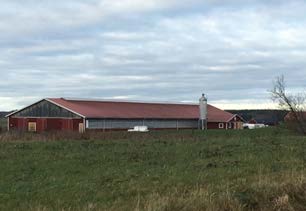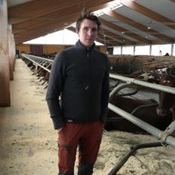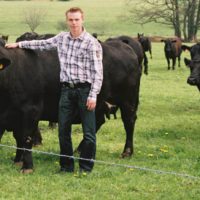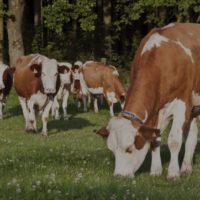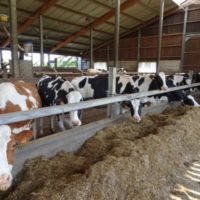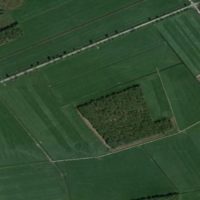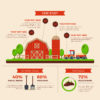Description
Background
Kårtorp Farm is a 250 ha farm including 130 ha forest, operated by father and son. In addition, 159 ha are rented. The farm lies close to the river Tidan, in a temperate continental climate in south-west Sweden with approximately 700 mm precipitation a year. Most of the arable land can be irrigated, including 110 of temporary grassland used for silage or grazing. There are 39 ha of flooded semi-natural grasslands close to the river and these are rich in grasses, legumes and herbs typical of areas that are flooded for part of the year. The farm receives EU grants through the agri-environment schemes on biodiversity for grazing these semi-natural grasslands. The farmer claims that this grant is crucial in enabling this part of the farm to be grazed with cross-breed heifers and steers (Swedish Red × Charolais).
On Kårtorp Farm, viable forage production has been the focus for many years. On this organic farm, the 210 dairy cows of the Swedish Red breed do a lot of grazing. According to the KRAV certification rules, milking cows have to graze at least 12 hours a day during the grazing season (5 months in this part of the country), graze at least 6 kg DM/day or at least get 50% of their forage from grazing. Therefore, it was important to plan the logistics carefully before farm expansion. There is an automatic milking system with four robots (GEA) and six full-time workers, including the two owners. Kårtorp Farm contracts in much of the machinery services needed for e.g. harro-wing, manure spreading and drilling.
Detailed description
When enlarging the farm by another 130 dairy cows in 2009, special effort was devoted to planning for extended grazing. A new house was placed in the middle of the available grasslands, to allow easy access to the paddocks from the parlour. The aim was to keep large milk production with more cows on the existing land area. There were two main targets in achieving this goal:
- To improve the grazing management to achieve high-yielding pastures with good profitability.
- To produce a high-quality silage for the dairy cows.
Grazing management is carefully planned on 28 ha of the temporary grassland at Kårtorp Farm. A seed mixture with Trifolium repens, Lolium perenne, Poa pratensis and Red fescue is sown at a rate of 20 kg/ha. The cows are let out in April–May. Recently milked cows are let out directly from the robot. Every morning, they are given new grass in a 1.5 ha area and they graze more than12 hours a day for 150 days a year. The stocking rate is 6.25 livestock units per ha and year. An attractive sward encourages the cows to graze. The area is strip-grazed the whole season, i.e. the cows move to another 3 ha paddock every second day. The pasture gets a rest period of 18 days after each defoliation and the total number of defoliations per season is 6.7 per paddock.
The paddocks are fertilised with 30 ton slurry per ha in the autumn, to re-circulate the nutrients and maintain soil fertility. They are also irrigated if necessary, depending on the weather in the actual season.
If the grass grows too fast, a cut of silage is taken. During the summer, the pasture is mown on average three times, to remove overmature and contaminated grass and encourage fresh regrowth.
Production of silage is also crucial for the farm’s finances. All heifers are moved to a ‘heifers´ hotel’ when they are four months old and are brought back to Kårtorp before calving. The result is that all forage from the 112 ha of temporary grasslands used for silage production to the dairy cows is of high and uniform quality. This is one reason why Kårtorp Farm was the winner of the Swedish Grass Silage Competition in 2018. A seed mixture with Trifolium pratense, Trifolium repens, Phleum pratense and Lolium perenne is sown, at a rate of 20 kg/ha. Tall fescue has been tested, but this species thrives best on more than three cuts per year, which is not optimal at Kårtorp Farm. Approximately 13–15 forage samples are taken for analysis per year, both on fresh herbage and in the silage from the three bunker silos. The results of the fresh forage analyses are used to evaluate the effect of the seed mixture and to determine the cutting height (amount of fibre needed) of the whole-crop cereals (Avena sativa, Hordeum vulgare, Triticum aestivum). The silage analyses are the basis for feed optimisation. The feed ration contains a significant proportion of silage and whole-crop cereals (60% of the diet, 13–14 kg DM per cow and day). Additives are only used if the grass is too wet or too dry, and also on the top of the bunker silos.
A new slurry lagoon was built during expansion, so that the slurry can be stored until spring, with better nitrogen efficiency as a result. By application of 60 tonnes slurry per ha, a nitrogen effect of 30 kg N/ha is achieved. Kårtorp Farm also applies 100 kg/ha Kiserit, adding 20 kg sulphur per ha, which is needed to maintain the large yield in organic production. The ability to irrigate most of the land is also essential in maintaining large production.
Results
Through the innovative management system used, the grass production in grazed paddocks delivers 5.0–5.5 tonnes per ha. The cows milk 10400 kg per year, which is very good in organic production. In 2017, the average milk yield for all cows in Sweden was 9760 kg energy-corrected milk. Milk production increases in early season, especially in May and June. To avoid a yield decrease later in the summer, in 2017 the farm started to irrigate not only the cut temporary grasslands but also its grazed pastures. The cost of machinery is approximately 445 Euro per ha and year. About 40% of this cost derives from contract machine services. The total cost for grass silage is 735 Euro per ha and year.
Adoption criteria
It is important to consider planning of house location, grazing paddocks and grassland management at the time of expansion. It is also important to work together to meet common targets. The staff must be positive and know what to do. Finally, monitoring work is important for further improvements.
Future prospects
Grazing management is a challenge in an expanding business. However, skilled grazing management is profitable and important, especially in organic production. Grazing is also essential from a consumer perspective, as the public want to see grazing animals in the landscape. Structured work, cooperation and communication on targets are three driving forces to get high-yielding pastures and good profitability in dairy production based on grazing. There are good possibilities for deeper learning about grazing management from research and from practice, both nationally and internationally. More developed farm advisory services on this issue are also needed.

